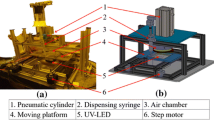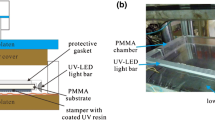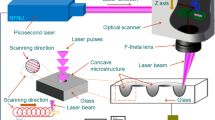Abstract
The microlens array is usually formed by thermal reflow of polymer disks and can be one microstructure of the light guide plate (LGP). Here, we propose an ultraviolet (UV) backside exposure technology to fabricate the photoresist cone-like microstructure on the PMMA substrate at room temperature and then use UV LIGA-like process to transfer the microstructure for the application of 3.6 in. (72 mm × 57.5 mm) LGP. The electroforming was used to transfer UV master mold to the inverse cone-like microstructure of nickel metal mold and then hot embossing was used for one more pattern transfer to the same cone-like microstructure on PMMA substrate. The optical microscope and alpha-stepper profiler were used to examine the morphology and profile of LGP microstructure. The optical luminance and uniformity of LGP were measured using BM9 luminance meter in comparison with commercial product. The light uniformity and luminance of the cone-like LGP microstructure reach 75–80% and 2,800–3,000 cd/cm2, respectively which meet the requirements of commercial LGP.
Similar content being viewed by others
Explore related subjects
Discover the latest articles, news and stories from top researchers in related subjects.Avoid common mistakes on your manuscript.
1 Introduction
With the development of information technology, flat panel display technique has made great progress these decades, especially in the development and application of liquid crystal display (LCD) technology. The thin film transistor-liquid crystal display (TFT-LCD) (Feng et al. 2004) has widely been used for a high-quality display because of its high brightness, thin dimension and low power consumption. The back light module (BLM) of LCD consists of three primary parts i.e. the optic thin films, the light guide plate (LGP) and the light source (Kashimu et al. 1992; Yokoyama et al. 1995). Figure 1 shows the schematic BLM which is composed of the light source of a cold cathode fluorescent lamp (CCFL) or light emitting diode (LED), a LGP, two diffusion sheets, two prism sheets and a reflection sheet. Because LCD cannot emit light for displaying its digitized information, the light produced by the BLM is transmitted through the LGP. The LGP consists of scattering patterns onto the bottom surface. They convert line- or point-shaped illumination from the side of LGP into surface-shaped illumination at the top surface by changing the propagating direction of the incident light (Chien and Chen 2009). Low luminous efficiency in BLM is always a serious problem and often leads to lower the LCD brightness and high power consumption. The enhanced luminous efficiency in BLM may reduce the number of light sources e.g. CCFL lamp tubes or LED at low cost and low power consumption. The variation of luminous efficiency in BLM is greatly concerned with LGP. Microlens array is a popular microstructure for the LGP which can be formed by thermal reflow of polymer disks (Popovic et al. 1988; Chung and Hong 2007), microdroplet of the polymer by microjetting technology (MacFarlane et al. 1994), patterning of the photoresist (PR) by gray-level mask method (Däschner et al. 1996) and so on. However, the taper angle of thermal reflowed microlens on the polymer substrate is difficult to adjust in a large range due to the surface tension of resist. The taper angle of LGP microstructure is a crucial factor to influence the back light luminescence from experiments and adjustable by exposure dose (Chung et al. 2007b). The smaller taper angles of 25°–40° are advantageous for high LGP luminous efficiency compared with angles larger than 54° (Chung et al. 2007b). In this paper, we first used the UV back-side exposure lithography (Chung et al. 2007a) to fabricate the lower taper angle of LGP microstructure on the PMMA substrate at room temperature. Then LIGA-like process with electroforming and hot embossing (Worgull and Heckele 2004; Scheer and Schulz 2001; Rowland and King 2004; Schulz et al. 2003) was used to transfer the pattern twice to get the same microstructure for verifying the feasibility of mass production. This approach is different from traditional LGP patterning which uses either microlenses made by thermal reflow of PR or machined V-cut grooves. Luminous efficiency of the tapered samples is measured and compared to the commercial reference sample.
2 Experimental procedures
Figure 2a–g shows the schematic diagrams of UV LIGA-like process flow for the fabrication of cone-like LGP microstructure. Figure 2a, b is for the lithography process with back side proximity exposure and development to form the JSR-resist cone-like microstructures due to diffraction effect. The mask is placed at the backside of PMMA substrate i.e. the opposite side of the JSR PR, and UV light illuminates from the substrate backside to transfer the mask patter to the front-side PR. This technology is different from the conventional front side exposure with the mask and PR being on the same side. Because of diffraction effect on proximity exposure, the resulting cone-like microstructure was formed after developing (Fig. 2b). Then Cr/Au (10/100 nm/nm) seed layers were deposited onto the cone-like microstructure by electron beam evaporator as shown in Fig. 2c. The duplicate nickel mold was obtained by electroforming which was performed in nickel sulphamate based solution, as shown in Fig. 2d, e. Finally, the duplicated PMMA cone-like micro-structure can be obtained via hot embossing process, as shown in Fig. 2f, g. Overall, the entire process includes back-side UV lithography, electroforming and hot embossing. The detailed process parameters were stated below.
In lithography, the 1 mm thick PMMA substrate was cleaned by isopropanol and acetone before the coating of the THB-121N JSR PR. The PMMA size is 57.5 mm × 72 mm i.e. 3.6 in. for commercial small-scale display. The number of designed circular pattern is 81565 for cone-like LGP. The JSR PR was coated on the front side of the transparent PMMA substrate and the UV light illuminated from the backside of substrate covered with the photo mask. Two-step PR spin coating was used for better uniformity. The first-step rotating speed was 250 rpm for 10 s, then the second-step is 1,000 rpm for 25 s by Tekstarter MSC-300D spin coater. The thickness of PR is around 40 μm. The soft bake of PR was performed at 85–90°C for 6 min on the hot plate. The backside exposure technology with photo mask and PR on the both sides of substrate was performed to obtain the cone-like microstructure. The taper angle can be adjusted to be smaller by the UV light dosage compared to the front side exposure. The exposure doses were controlled at 200–600 mJ/cm2 by OAI 500-IR mask aligner with the filtered 365 nm UV light. The post expose bake of PR was performed at 80°C for 5 min on the hot plate. The development was done by JSR development solution for 2 min. The hard bake of PR was performed at 85°C for 10 min on the hot plate. After PR development and hard bake the cone-like tapered microstructures could be obtained. From our previous result (Chung et al. 2007b), the cone-like microstructure with a taper angle of 25°–40° can exhibit a better uniformity and luminance than the high angle larger than 54°. Therefore, the better cone-like microstructures with a taper angle about 34° ± 4° were selected in this study for the subsequent LIGA-like processes consisting of Cr/Au (10/100 nm/nm) metal seed layer deposition, electroforming of Ni mold (~1 mm) and hot embossing of PMMA. In electroforming, the composition of the bath solution was controlled by nickel sulphamate of 450 g/l, nickel chloride of 3–5 g/l, and boric acid 40 g/l. The temperature was kept at 50 ± 1°C. The initial PH of the electrolyte was controlled at 4.2. The current density was fixed at 4 Adm−2. In hot embossing, the transparent 1 mm thick PMMA is chosen as the light-guiding material for the following Ni-mold embossing at high temperature. The glass transition temperature (T g) of PMMA is around 105°C, thus the embossing temperature has to be higher than T g to mold PMMA. The operation parameters of embossing temperature, pressure and duration were 110–140°C, 4–6 kg/cm2 and 20 min, respectively. The morphology and light luminance of cone-like LGP microstructures were examined by optical microscope (OM, Olympus BX51, Japan), alpha-step (α-step) profiler (Kosaka Lab, Surfcorder ET3000, Japan) and BM9 luminance meter (Topcon, Taiwan), respectively. The uniformity (U) of luminance was calculated by 9-point method (Chien and Chen 2009) using equation as U = L min /L max where L min is the minimum luminance and L max is the maximum luminance.
3 Results and discussion
Figure 3a, b shows the optical micrograph and alpha-stepper measured profile of JSR cone-like microstructure after UV backside exposure lithography process, respectively. The cone-like microstructure formed at the exposure dose of 400 mJ/cm2 has a tapered angle about 34° and the height about 25.9 μm. The conventional taper angles by front side exposure experiments are in the range of 45°–65° due to diffraction effect. As stated above, the lower tapered angle is beneficial for the enhancement of light uniformity and luminance (Chung et al. 2007b). Figure 4 shows the schematic diagram of taper angle definition of the cone-like microstructure which is centered at the vertex between a pair of compasses. The combined measurement tolerance and fabrication error is around 4°. The 34° ± 4° JSR cone-like microstructures were used for the following LIGA-like processes. Figure 5a, b shows the optical micrograph and alpha-stepper measured profile of Ni metal mold with JSR inverse pattern after electroforming, respectively. The concave depth is about 26.3 μm and the taper angle about 35°. It indicates that good pattern transfer of JSR microstructure has been done into the Ni mold.
The pattern transfer of Ni mold to PMMA during hot embossing is much concerned with the embossing temperature and pressure. Because the glass transition temperature of PMMA is around 105°C, the testing embossing temperatures were performed between 110 and 140°C. It is found that poor pattern transfer with much smaller tapered height occurs at temperatures lower than 115°C and that severe pattern distortion happens at temperatures higher than 135°C. Figure 6a, b shows the optical micrographs of the PMMA after embossing at 110 and 140°C at 5 kg/cm2, respectively. As indicated by red circles on images, insufficient thermal energy at low temperature of 110°C leads to the small plastic deformation for poor pattern transfer and over heating at high temperature of 140°C results in the large pattern distortion. Therefore, hot embossing experiments at most pressures of 4–6 kg/cm2 were performed at 120 and 130°C. Figure 7 shows the taper angle of the hot-embossed PMMA LGP microstructure as a function of embossing pressure at 120 and 130°C for 20 min. The pressures are 4, 4.5, 5, 5.5, and 6 kg/cm2. The mean taper angles each pressure formed at 120°C embossing are around 33.0° ± 2.5° while those at 130°C embossing are more reliable around 33.5° ± 0.5°. The height of tapered microstructure is also stable around 26.2 ± 1.0 μm. The higher temperature of 130°C makes lower viscosity of PMMA to flow easy to fill in the Ni mold than that at 120°C. This leads to the more reliable embossing for pattern transfer at 130°C. Also, the 130°C is an endurable temperature of PMMA without thermal distortion during embossing compared to that at 140°C (Fig. 6b). Figure 8a, b shows the optical micrograph and alpha-stepper measured profile of cone-like LGP microstructure of PMMA after hot embossing at 130°C and 5 kg/cm2 for 20 min, respectively. The taper angle is about 34° and the height is about 25.4 μm. As discussed above, good pattern transfer of PMMA cone-like LGP microstructure has been achieved by using UV LIGA-like process based on the back side exposure process.
The finished PMMA cone-like LGP microstructure is further used for luminance measurement at nine test positions (Chien and Chen 2009) which follows Illuminating Engineering Society Standards IES LM-79 -08 from American National Standards Institute. Figure 9a, b shows the BM9 measured light luminescence image and the 9-spot values of the good PMMA cone-like LGP microstructure in Fig. 8, respectively. The diagonal length of LGP is 3.6 in. corresponding to the LGP size of 72 mm in length and 57.5 mm in width. The 9-spot method here was used to identify the average luminance and uniformity. The nine luminance values at the center of nine positions from left to right and top to down are 3,010, 3,300, 2,980, 2,630, 2,860, 2,680, 2,820, 3,000 and 3,040 cd/cm2. The average luminance is about 2,920 cd/cm2 and uniformity is about 77%. It is comparable with the BM9 measured commercial product of 65–80% uniformity and 2,750–3,050 cd/cm2 luminances at the same measurement instrument and conditions. It implies that our back-side-exposure UV LIGA-like process is suitable for the batch fabrication of PMMA cone-like LGP microstructure for future commercialization.
a The BM9 measured light luminescence image and b the 9-spot values of the good PMMA cone-like LGP microstructure in Fig. 8
4 Conclusions
The cone-like LGP microstructure has been demonstrated by using UV LIGA-like process. The backside exposure was used for lithography at doses of 200–600 mJ/cm2. The tapered angle of JSR on the PMMA substrate exposed at 400 mJ/cm2 is about 34° and the height about 25.9 μm after development. It is smaller than conventional tapered structure with angles of 45°–65°. The lower tapered angle is good for better luminous efficiency compared to the conventional thermal reflowed microlens or front side exposure lithography. Good pattern transfer of PMMA cone-like LGP microstructure can been achieved at proper parameters of electroforming and hot embossing. It is found that poor pattern transfer with much smaller taper height occurs at temperatures lower than 115°C and the severe pattern distortion happens at temperatures higher than 135°C. The good PMMA LGP was stably obtained by hot embossing at 130°C at 5 kg/cm2 for 20 min. The average luminance is about 2,920 cd/cm2 and uniformity is about 77% which meet the requirements of commercial LGP.
References
Chien HC, Chen ZP (2009) The study of integrated LED-backlight plate fabricated by micromachining technique. Microsyst Technol 15:383–389
Chung CK, Hong YZ (2007) Fabrication and analysis the reflowed microlens arrays using JSR THB-130N photoresist. Microsyst Technol 13:523–530
Chung CK, Hong YZ, Chang WT (2007a) Fabrication of the monolithic polymer-metal microstructure by the backside exposure and electroforming technology. Microsyst Technol 13:531–536
Chung CK, Sher KL, Hsiao EJ, Wu MY (2007b) Fabrication of light guide plate using backside exposure lithography, International Display Manufacturing Conference and Exhibition 2007, Taipei, Taiwan (IDMC 2007 Fri-S21-06):417–419
Däschner W, Long P, Stein R (1996) General aspheric refractive micro-optics fabricated by optical lithography using a high energy beam sensitive glass gray-level mask. J Vac Sci Technol B 14:3730–3733
Feng D, Jin G, Yan Y, Fan S (2004) High quality light guide plates that can control the illumination angle based on microprism structures. Appl Phys Lett 85:6016–6018
Kashimu K, Yoshida N, Shoji O, Yanagi E, Fukunishi T (1992) Back lighting device for a panel. US-Patent 5093765
MacFarlane DL, Narayan V, Tatum JA, Cox WR, Chen T, Hayes DJ (1994) Microjet fabrication of microlens arrays. IEEE Photon Technol 6:1112–1114
Popovic ZD, Sprague RA, Connell GAN (1988) Technique for monolithic fabrication of microlens arrays. Appl Opt 27:1281–1284
Rowland HD, King WP (2004) Polymer deformation and filling modes during microembossing. J Micromech Microeng 14:1625–1632
Scheer H-C, Schulz H (2001) A contribution to the flow behaviour of thin polymer films during hot embossing lithography. Microelectron Eng 56:311–332
Schulz H, Wissen M, Scheer H-C (2003) Local mass transport and its effect on global pattern replication during hot embossing. Microelectron Eng 67–68:657–663
Worgull M, Heckele M (2004) New aspects of simulation in hot embossing. Microsyst Technol 10:432–437
Yokoyama K, Ishikawa T, Watai K (1995) Surface illuminant device. US-Patent 5402324R
Acknowledgments
This work is sponsored by Chi Mei Optoelectronics Corp. (CMO) under National Cheng Kung University (NCKU)-CMO collaborated project. We pay our great thanks to the Center for Micro/Nano Science and Technology (CMNST) at NCKU and CMO for the access of process and analysis equipments.
Author information
Authors and Affiliations
Corresponding author
Rights and permissions
About this article
Cite this article
Chung, C.K., Sher, K.L., Syu, Y.J. et al. Fabrication of cone-like microstructure using UV LIGA-like for light guide plate application. Microsyst Technol 16, 1619–1624 (2010). https://doi.org/10.1007/s00542-009-1012-1
Received:
Accepted:
Published:
Issue Date:
DOI: https://doi.org/10.1007/s00542-009-1012-1













